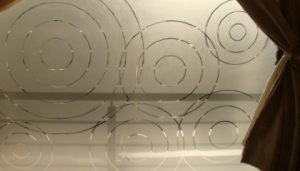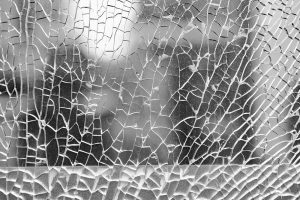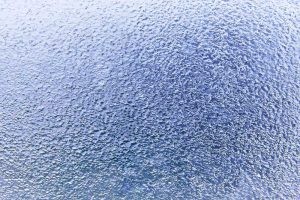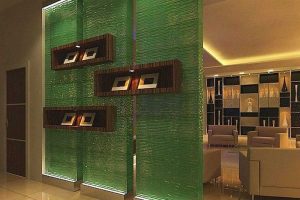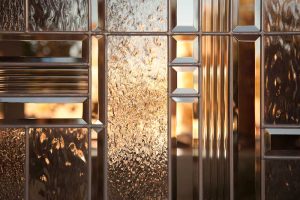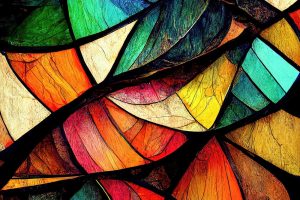Decorative glass, also known as ornamental glass, goes beyond mere functionality. It is specifically designed to enhance aesthetics, transform spaces, and evoke emotions. Here are types of decoratives-glass-solutions:
1. Sand Blasted Glass
GET IN TOUCH
What is Sand Blasted Glass?
- High-pressure air and fine sand particles are used to etch patterns, designs, or textures onto the glass surface during the transformative process of sandblasting glass, also known as frosted glass.
- The sandblasting technique creates a frosted appearance by removing layers of glass, resulting in a semi-translucent finish.
- This decorative glass treatment is versatile and finds applications in both residential and commercial spaces.
How is Sand Blasted Glass Created?
The sandblasting process involves the following steps:
- Preparation: The glass surface is thoroughly cleaned and dried.
- Masking: A stencil or masking material is applied to the glass, covering the areas that should remain clear.
- Sandblasting: High-pressure air is used to propel fine sand particles against the glass surface. The sand erodes the exposed areas, creating the desired design.
- Removal of Masking: After sandblasting, the masking material is removed, revealing the frosted design.
- Finishing: The glass may undergo additional treatments, such as polishing or sealing, to enhance its appearance and durability.
Applications of Sand Blasted Glass
- Privacy: Sandblasted glass provides privacy while allowing natural light to filter through. It’s commonly used for windows, doors, and shower enclosures.
- Interior Design: You can incorporate sandblasted glass panels into room dividers, partitions, and decorative screens.
- Signage and Branding: Sandblasted glass can feature company logos, names, or other custom designs for branding purposes.
- Artistic Installations: Artists and designers use sandblasted glass to create intricate patterns, landscapes, and abstract art.
Advantages of Sand Blasted Glass
- Aesthetic Appeal: Sandblasted glass adds elegance and uniqueness to spaces. It softens harsh light and diffuses it evenly.
- Customization: The level of opacity and design complexity can be tailored to suit specific preferences.
- Low Maintenance: Sandblasted glass is easy to clean and doesn’t show fingerprints or smudges as prominently as clear glass.
- Light Diffusion: It allows natural light to enter while maintaining privacy.
Care and Maintenance
- Clean sandblasted glass with a mild glass cleaner and a soft cloth.
- Avoid abrasive materials that could scratch the frosted surface.
- Regular maintenance ensures the longevity of the design.
2. Decorative Mirrors
GET IN TOUCH
Functionality and Aesthetics
- Amplifying Light: Mirrors have the remarkable ability to bounce light around a room, making it appear brighter and more spacious. Placing mirrors strategically can enhance natural and artificial lighting.
- Creating Illusions: Decorative mirrors can visually expand small spaces, making them feel larger. They’re like magic tricks for interior design!
- Focal Points: An ornate mirror can serve as a captivating focal point in any room. It draws attention and adds a touch of elegance.
Types of Decorative Mirrors
- Antique Mirrors: These mirrors exude history and charm. Their intricate frames, often gilded or carved, tell stories of bygone eras. Antique mirrors work well in traditional or eclectic interiors.
- Contemporary Designs: Sleek, frameless mirrors with clean lines are perfect for modern spaces. They blend seamlessly into minimalist aesthetics.
- Venetian Mirrors: Originating from Venice, these mirrors feature delicate etching, beveled edges, and decorative motifs. Venetian mirrors add glamour and sophistication.
- Sunburst Mirrors: Sunburst mirrors have radiating spokes resembling the sun. They infuse rooms with energy and a touch of whimsy.
- Oversized Mirrors: Large mirrors create drama and depth. Lean an oversized mirror against a wall or hang it above a console table for impact.
Placement Tips
- Opposite Windows: Position mirrors across from windows to reflect natural light and outdoor views.
- Above Mantels: A mirror above a fireplace mantel adds symmetry and draws attention to the focal point.
- Hallways: Mirrors in narrow hallways create an illusion of width.
- Grouping: Arrange smaller mirrors in a cluster for an artistic display.
Customization and Artistry
- Etched Designs: Mirrors can be etched with patterns, floral motifs, or geometric shapes.
- Colored Mirrors: Tinted or colored mirror glass adds vibrancy and uniqueness.
- Mosaic Mirrors: Tiny mirrored tiles create mosaic patterns, adding texture and visual interest.
Maintenance
- Regularly clean mirrors with a soft, lint-free cloth and mild glass cleaner.
- Avoid harsh chemicals that can damage the reflective coating.
3. Crackled Glass
GET IN TOUCH
What is Crackled Glass?
- Crackled glass, also known as shattered glass or fractured glass, is a type of decorative glass that intentionally features irregular cracks, fissures, and patterns.
- These cracks create a mesmerizing effect, capturing light and casting intricate shadows.
- Crackled glass is often used for artistic and architectural purposes, adding depth and visual interest to various applications.
How is Crackled Glass Created?
Controlled stress or thermal shock achieves the crackling effect during the glassmaking process:
- Annealing: The glass is initially heated and then slowly cooled to relieve internal stresses.
- Rapid Cooling: The glass is rapidly cooled, causing surface tension and internal stress differences.
- Cracking: Controlled cracks form on the surface, creating the desired pattern.
- Finishing: The cracked glass is polished to enhance its appearance and safety.
Applications of Crackled Glass
- Decorative Panels: Crackled glass panels serve as stunning room dividers, cabinet doors, or wall art.
- Lighting Fixtures: Pendant lights, chandeliers, and table lamps with crackled glass shades emit a warm, diffused glow.
- Furniture: Incorporate crackled glass into tabletops, shelves, or cabinet doors for a unique touch.
- Art Installations: Artists use crackled glass to create sculptures, mosaics, and other expressive pieces.
Design Tips
- Contrast: Pair crackled glass with smooth surfaces (like wood or metal) to highlight its texture.
- Backlighting: Install crackled glass near light sources to emphasize its cracks and create captivating visual effects.
- Color Variations: Crackled glass comes in various colors, allowing you to match it to your design palette.
Maintenance
- Clean crackled glass with a soft cloth and mild glass cleaner.
- Avoid abrasive materials that could worsen existing cracks.
4. Acid Textured Glass
GET IN TOUCH
What is Acid-Textured Glass?
- Acid-etched textured glass, also known as frosted glass, undergoes a chemical process to alter its surface appearance.
- The glass is treated with acid or other chemicals, which create a matte, translucent finish.
- This type of glass strikes a balance between elegance and functionality, making it a favorite among architects and interior designers.
Applications of Acid-Textured Glass
- Windows and Doors: Acid-textured glass provides privacy while allowing natural light to filter through. It’s commonly used in bathroom windows, entry doors, and interior partitions.
- Shower Enclosures: Frosted glass adds a touch of luxury to shower enclosures. It diffuses light, creating a soft glow without compromising privacy.
- Custom Installations: Acid-etched glass can be customized with various patterns, designs, or logos. It’s ideal for corporate offices, hotels, and retail spaces.
- Backlit Panels: When backlit, acid-textured glass becomes a stunning feature, casting a gentle radiance.
Design Advantages
- Privacy: Acid-etched glass obscures views while maintaining an open feel. It’s perfect for spaces where privacy is essential.
- Light Diffusion: The frosted surface scatters light, reducing glare and creating a pleasant ambiance.
- Easy Maintenance: Acid-textured glass is easy to clean and doesn’t show fingerprints as prominently as clear glass.
- Aesthetic Appeal: The subtle texture adds sophistication without overwhelming the design.
Variations
- Fine Etching: Delicate patterns or fine lines create a subtle effect.
- Heavy Etching: Bolder patterns or deeper etching provide more privacy.
- Custom Designs: Acid-etched glass can feature custom designs, logos, or branding elements.
Maintenance Tips
- Clean acid-textured glass with a mild glass cleaner and a soft cloth.
- Avoid abrasive materials that could scratch the frosted surface.
5. Stacked Glass
GET IN TOUCH
What is Stacked Glass?
- Stacked glass, also known as layered glass or laminated glass, involves combining multiple glass sheets to create a single, visually striking panel.
- These layers can be of varying thicknesses, colors, or textures, resulting in a dynamic interplay of light and shadow.
Applications of Stacked Glass
- Feature Walls: Stacked glass panels serve as stunning feature walls in both residential and commercial spaces. The layered effect adds depth and drama.
- Partitions and Dividers: Use stacked glass to separate different areas within a room while maintaining an open feel. It’s an elegant alternative to solid walls.
- Art Installations: Artists and designers create sculptures, installations, and decorative pieces using stacked glass. The transparency and layering evoke curiosity and wonder.
Design Considerations
- Transparency Levels: Depending on the desired effect, choose transparent, translucent, or opaque glass layers.
- Color Play: Stacked glass allows for creative color combinations. Imagine layers of blue, green, and clear glass merging seamlessly.
- Texture Variation: Incorporate textured glass layers for added visual interest. Frosted, ribbed, or patterned glass can enhance the overall effect.
Light and Shadow Dynamics
- Natural Light: Stacked glass interacts with natural light, creating shifting patterns throughout the day. Sunlight filters through, casting beautiful shadows.
- Artificial Lighting: Backlighting or strategically placed spotlights enhance the layers, emphasizing their depth.
Installation Techniques
- Lamination: Specialized adhesives or interlayers (such as PVB or EVA) bond the layers together. Laminated glass ensures safety and durability.
- Customization: Stacked glass can be customized to fit specific dimensions and design preferences.
Maintenance
- Clean stacked glass with a soft cloth and mild glass cleaner.
- Avoid abrasive materials that could scratch the glass surface.
6. Beveled Glass
GET IN TOUCH
What is Beveled Glass?
- Beveled glass refers to glass with angled edges, creating a chamfered or sloping effect along its perimeter.
- The beveling process involves cutting and polishing the edges at specific angles, typically 45 degrees.
- Engineering prizes beveled glass for its ability to catch and refract light, adding depth and visual interest.
Applications of Beveled Glass
- Doors and Windows: Engineering commonly uses beveled glass panels in doors, windows, and transoms. They enhance both interior and exterior aesthetics.
- Decorative Panels: Beveled glass adds elegance to decorative panels, such as cabinet doors, room dividers, and display cases.
- Mirrors: Beveled mirrors create a luxurious look. The angled edges frame the reflective surface beautifully.
Design Advantages
- Light Play: Beveled edges catch sunlight or artificial light, creating sparkling reflections and enhancing the overall ambiance.
- Illusion of Space: Beveled mirrors placed strategically can make a room appear larger by bouncing light around.
- Sophistication: The beveled effect adds a touch of luxury and elegance to any setting.
Variations
- Single Bevel: One side of the glass is beveled, creating a subtle effect.
- Double Bevel: Engineering bevels both sides of the glass, resulting in a more pronounced chamfer.
- Custom Designs: Beveled glass can feature intricate patterns or custom shapes.
Maintenance
- Clean beveled glass with a soft cloth and mild glass cleaner.
- Pay attention to the edges to maintain their brilliance.
7. Stained Glass
GET IN TOUCH
Origins and Artistry
- Ancient Roots: Stained glass dates back to medieval times, where it adorned the grand cathedrals of Europe. Skilled artisans meticulously crafted intricate designs using colored glass pieces.
- Materials: Stained glass primarily consists of colored glass, often in shades of red, blue, green, and gold. Engineering can optimize natural light while minimizing heat gain.
Symbolism and Stories
- Religious Context: Stained glass windows in churches and religious buildings depict biblical scenes, saints, and religious symbols. Each panel tells a story, educating and inspiring worshippers.
- Narrative Beauty: The play of light through stained glass brings these narratives to life. Sunlight transforms the glass into a kaleidoscope of colors, evoking awe and reverence.
Architectural Integration
- Cathedrals and Chapels: Stained glass windows are a hallmark of Gothic architecture. They illuminate the interiors, creating an otherworldly atmosphere.
- Historic Buildings: From castles to manors, stained glass graced the homes of nobility and royalty. It symbolized wealth, culture, and spirituality.
- Modern Spaces: Contemporary architects incorporate stained glass into public buildings, museums, and even private residences. It bridges tradition and innovation.
Craftsmanship and Techniques
- Lead Came Technique: Artisans cut and shape individual glass pieces, then assemble them using lead cames. The joints are soldered for stability.
- Painted Glass: Some stained glass features painted details, enhancing the overall design.
- Tiffany Style: Louis Comfort Tiffany popularized the use of opalescent glass, creating luminous, iridescent effects.
Emotional Impact
- Spiritual Reverence: Stained glass windows inspire contemplation and devotion. They connect worshippers to divine stories and eternal truths.
- Aesthetic Delight: Beyond religious contexts, stained glass adds beauty to secular spaces. It invites us to pause and appreciate the interplay of color and light.
Maintenance and Preservation
- Careful Cleaning: Stained glass requires gentle cleaning with soft brushes and mild solutions.
- Restoration: Skilled conservators repair damaged panels, ensuring their longevity.
8. Dubai’s Architectural Revolution
Dubai, known for its futuristic skyline and ambitious projects, continues to redefine urban living. As glass becomes an integral part of architectural design, here’s how decorative glass solutions will shape Dubai’s future:
Sustainable Innovations
- Energy Efficiency: Decorative glass optimizes natural light while minimizing heat gain through engineering. Low-E coatings and smart glass technologies enhance energy efficiency.
- Solar Integration: Imagine facades adorned with photovoltaic glass panels, harnessing solar energy while maintaining aesthetics.
Iconic Landmarks
- Burj Khalifa: The world’s tallest building already features stunning glass cladding. Future renovations may incorporate decorative glass elements, celebrating Dubai’s heritage.
- Dubai Creek Tower: As this architectural marvel rises, expect innovative glass designs that blend tradition and modernity.
Biophilic Design
- Green Facades: Decorative glass can integrate greenery, creating vertical gardens within buildings. Imagine glass panels adorned with lush plants.
- Natural Patterns: Etched or textured glass mimicking natural patterns (leaves, waves, or sand dunes) will connect occupants to the environment.
Interactive Surfaces
- Smart Glass: Beyond mere aesthetics, decorative glass will become interactive. Switchable glass can change opacity, providing privacy or revealing stunning views.
- Projection Mapping: Imagine glass facades as dynamic canvases for art, culture, and storytelling.
Cultural Expressions
- Islamic Art: Stained glass windows inspired by traditional Islamic geometric patterns will adorn mosques and cultural centers.
- Calligraphy and Symbolism: Etched glass panels may feature Arabic calligraphy, celebrating language and heritage.
Floating Architecture
- Floating Hotels and Restaurants: Glass-bottomed structures will allow guests to dine or sleep above water, surrounded by marine life.
- Underwater Lounges: Imagine sipping coffee while gazing at coral reefs through transparent glass walls.
Sky Gardens and Atriums
- Vertical Green Spaces: Glass atriums will house lush gardens, creating microclimates within skyscrapers.
- Sky Bridges: Glass walkways connecting towers will offer breathtaking views of the city.
Art Installations
- Interactive Glass Art: Public spaces will feature sculptures and installations made of illuminated glass, responding to human movement.
- Light Festivals: Dubai’s festivals will include glass-themed light shows, transforming the cityscape.
Resilience and Safety
- Hurricane-Resistant Glass: As climate change impacts intensify, decorative glass will prioritize safety without compromising aesthetics.
- Fire-Resistant Coatings: Fire-rated glass will protect occupants while maintaining transparency.
Cultural Fusion
- Global Influences: Dubai’s multicultural population will inspire diverse glass designs, blending East and West.
- Innovative Materials: Expect glass infused with local sands, pearls, or recycled materials.
For personalized glass solutions that exceed expectations, Glass World can be your trusted partner. Get in touch with us today to explore our extensive range and find the ideal glass products for your projects.


